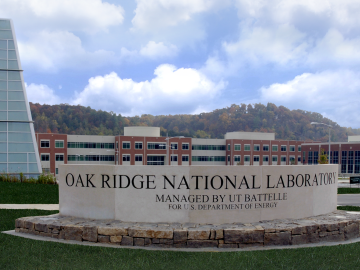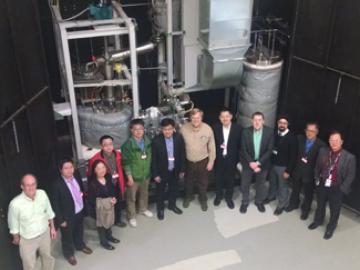Filter News
Area of Research
- (-) Functional Materials for Energy (3)
- (-) Nuclear Science and Technology (5)
- (-) Transportation Systems (2)
- Advanced Manufacturing (3)
- Biological Systems (3)
- Building Technologies (2)
- Chemical and Engineering Materials (1)
- Chemistry and Physics at Interfaces (3)
- Clean Energy (34)
- Energy Frontier Research Centers (4)
- Geographic Information Science and Technology (1)
- Isotope Development and Production (1)
- Materials (28)
- Materials Synthesis from Atoms to Systems (2)
- Materials Under Extremes (3)
- Neutron Data Analysis and Visualization (2)
- Neutron Science (4)
- Quantum Condensed Matter (1)
- Reactor Technology (1)
- Supercomputing (14)
News Type
Media Contacts

With the production of 50 grams of plutonium-238, researchers at the Department of Energy’s Oak Ridge National Laboratory have restored a U.S. capability dormant for nearly 30 years and set the course to provide power for NASA and other missions.




A research demonstration unveiled today at the Department of Energy’s Oak Ridge National Laboratory combines clean energy technologies into a 3D-printed building and vehicle to showcase a new approach to energy use, storage and consumption. The Additive Manufactur...


Six researchers with the Department of Energy's Oak Ridge National Laboratory received awards at this week's Society of Automotive Engineers International (SAE) World Congress. Scott Sluder received SAE's Lloyd L. Withrow Distinguished Speaker Award, which ...

Less than 1 percent of Earth’s water is drinkable. Removing salt and other minerals from our biggest available source of water—seawater—may help satisfy a growing global population thirsty for fresh water for drinking, farming, transportation, heating, cooling and industry. But desalination is an energy-intensive process, which concerns those wanting to expand its application.

Representatives from the Oak Ridge National Laboratory (ORNL) and the Shanghai Institute of Applied Physics (SINAP) are meeting at ORNL this week as part of an agreement between the two institutions to work together on the advancement

Graphene, a strong, lightweight carbon honeycombed structure that’s only one atom thick, holds great promise for energy research and development. Recently scientists with the Fluid Interface Reactions, Structures, and Transport (FIRST) Energy Frontier Research Center (EFRC), led by the US Department of Energy’s Oak Ridge National Laboratory, revealed graphene can serve as a proton-selective permeable membrane, providing a new basis for streamlined and more efficient energy technologies such as improved fuel cells.




